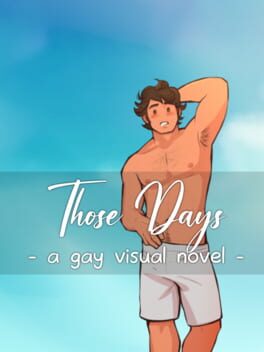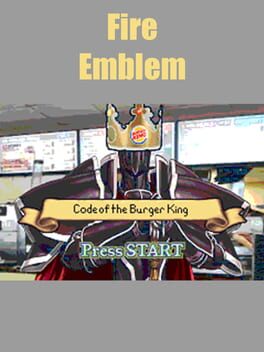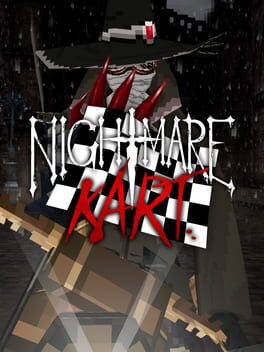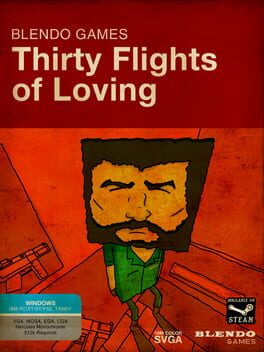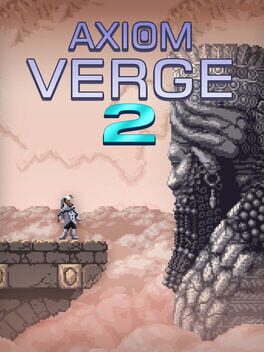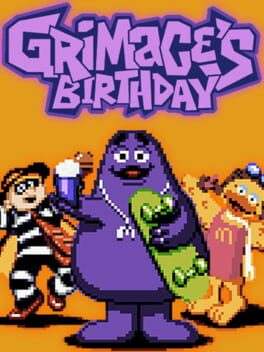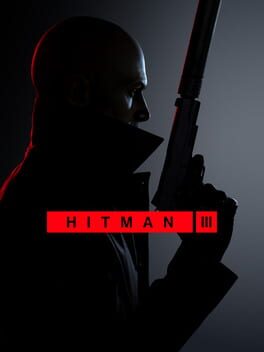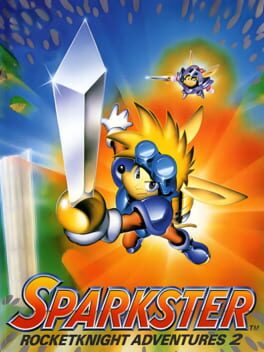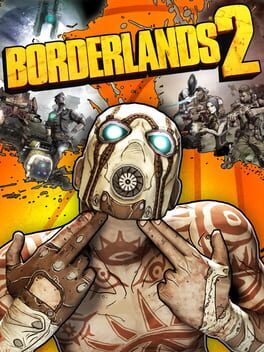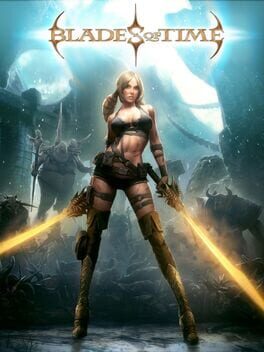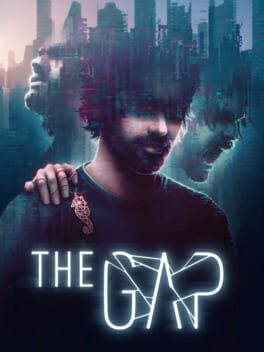702 Reviews liked by Ens1s
Those Days
TBD
It was okay! The adult scenes were cute and wholesome, but it felt like the story was zooming forward and there wasn't much to it in general. It was also unfinished and from what I read around it seems that the creator has disappeared, so it will probably never get finished.
Either way it was free, fun artstyle and rather wholesome for a gay adult VN game. It's alright, but could have been better.
Either way it was free, fun artstyle and rather wholesome for a gay adult VN game. It's alright, but could have been better.
Fire Emblem: Code of the Burger King is a greater celebration of the series than Fire Emblem Engage.
I know this sounds really conceited and runs the risk of "Nintendo hire this man" rhetoric but let me explain. Regardless of your opinions on a title as polarizing as Engage, the inherent idea of focusing on the main lords as a group of friends happily getting along fundamentally can not represent Fire Emblem the idea. Every Fire Emblem game has at least one massive thorn that hinders people from liking it, be that frictional game design decisions, sloppy writing, the multitude of reactionary and/or otherwise disgusting aspects throughout the series, or in most cases, all three combined. To put this into perspective, the most likely candidate for the most universally beloved game in the series among those who've played it is the one with infamously slow paced gameplay and also a playable minstrel stereotype. As such, there's this inherent air of cynicism to Fire Emblem that makes it, be it through older fans wishing for the series' death already or newer fans jokingly referring to their preferred games in the series as dating sims. I don't care for a lot of tonally similar game franchises (i.e. Persona, Xenoblade, Trails) yet I am an avid enjoyer of Fire Emblem for how weird and frictional it can be at points as well as how your enjoyment of it effectively turns you into the RPG fan equivalent of a heel wrestler. It is impossible for official attempt at a Fire Emblem celebration to capture what makes the series appealing to a significant portion of its playerbase, as doing so would require Nintendo and Intelligent Systems to reveal the man behind the curtain and shatter the facade behind their advertised image of the series.
Enter Code of the Burger King, a Fire Emblem rom hack with the core appeal of being a meme hack with surprising levels of mechanical depth and effort in other avenues. The opening chapters of this hack follow the typical Fire Emblem set up of a royal or otherwise important figure (the latter in this case) fleeing their homeland due to some unexpected danger but with the twist that the main character BK, the Tellius games' popular antagonist, did this because of an annoying customer at his shitty fast food job, creating a juxtaposition between the fantastical and the mundane or otherwise cynical. Similar juxtapositions exist all throughout Code of the Burger King: This game's Jagen (i.e. strong prepromote that joins early and will almost certainly be of great importance to your performance in the first few chapters) is Fiona, a notoriously scuffed gameplay unit due to a possible coding error. Duo Geno Escapo, a rom hack widely disliked by the community for its low effort edgelord humor is portrayed as a mythical evil/Brothers Grimm style legend passed down through generations coming true. And one of the most important moments in the development of RPG storytelling, Final Fantasy IV's Cecil Harvey turning from bad knight to good knight (good night for you) and accepting his role as a prophesized hero through an act of mercy, is distorted to be about fulfilling the destiny of a fast food chain with food that doesn't even taste good.
In particular, there's a running gag that the hack's enemies are appearing out of nowhere as if they only exist to be fodder for video game missions with no minds of their own. The cause of these occurrences is a version of corporate mascot, Touhou meme, and apartheid supporter Ronald McDonald with the personality, nihilistic outlook, and banger boss theme of Final Fantasy VI's Kefka Palazzo. Upon defeating him in the final map, our protagonist admits he has a point about life having no intrinsic meaning but instead sees that revelation as a jumping off point to find your own meaning, a parody of the tendency of plenty of RPGs to act like they're deeper than they actually are for skimming the Wikipedia page for existentialism with little to add beyond that that is then followed up by BK's partner in yaoi assuming he's intoxicated from volcano smoke.
However, in a way, this existentialist philosophy of ascribing your own meaning onto the meaningless is what is necessary to be a Fire Emblem fan. Code of the Burger King isn't just a tribute to vanilla Fire Emblem through its decision to feature elements from across the series but also a tribute to the value that various fans have managed to get out of the series. Members of the playable cast include Hugh, a personal favorite of the hack's creator, Matthis, the loser cavalier propelled to a beloved character in small circles because of one man's actions, and Rebecca and Priscilla, a pair of characters that have literally never interacted with each other once in the actual game they came from but have been turned into a niche lesbian pairing due to a rom hacker's attempt at an FE7 rebalance and subsequent Twitter gaslighting campaign. For any fault I can find with Code of the Burger King's gameplay (Chapter 13 plays like ass and also I really do not like the decision to have relatively large deployment limits in a way that can sometimes mess with the pacing of turns and discourages me from engaging with permadeath due to the game's smaller sized cast) and for any joke that doesn't land, Code of the Burger King exceeds not just as one of the best examples of the fast paced player phase focused gameplay that's become the bread and butter of FE hacks but also as a genuine celebration of everything to happen in the series' three decades of existence, be it good or bad.
Move over Final Fantasy IX, Persona 3, and Nier, this is what a real 40 hour RPG that tells you life is worth living at the end looks like.
Last Minute Disclaimers:
1. At the risk of coming off as too preachy for a review of a Fire Emblem rom hack, I support the BDS targeted boycott against Burger King, McDonalds, and other brands involved in reinforcing a disgusting apartheid regime and urge you all to do the same. I personally read the game's use of these two brands is very much a joke at their expense but it is very awkward to talk about a hack with "Burger King" in the name given current events so I feel the need to specify this.
2. I have regular contact with the hack's creator through various avenues (one of which being my own public Discord server before I deleted it due to a long story involving someone joining just to post an Andrew Tate cock gif) and have beaten his ass in multiple Pokémon draft league matches so feel free to accuse me of nepotism.
I know this sounds really conceited and runs the risk of "Nintendo hire this man" rhetoric but let me explain. Regardless of your opinions on a title as polarizing as Engage, the inherent idea of focusing on the main lords as a group of friends happily getting along fundamentally can not represent Fire Emblem the idea. Every Fire Emblem game has at least one massive thorn that hinders people from liking it, be that frictional game design decisions, sloppy writing, the multitude of reactionary and/or otherwise disgusting aspects throughout the series, or in most cases, all three combined. To put this into perspective, the most likely candidate for the most universally beloved game in the series among those who've played it is the one with infamously slow paced gameplay and also a playable minstrel stereotype. As such, there's this inherent air of cynicism to Fire Emblem that makes it, be it through older fans wishing for the series' death already or newer fans jokingly referring to their preferred games in the series as dating sims. I don't care for a lot of tonally similar game franchises (i.e. Persona, Xenoblade, Trails) yet I am an avid enjoyer of Fire Emblem for how weird and frictional it can be at points as well as how your enjoyment of it effectively turns you into the RPG fan equivalent of a heel wrestler. It is impossible for official attempt at a Fire Emblem celebration to capture what makes the series appealing to a significant portion of its playerbase, as doing so would require Nintendo and Intelligent Systems to reveal the man behind the curtain and shatter the facade behind their advertised image of the series.
Enter Code of the Burger King, a Fire Emblem rom hack with the core appeal of being a meme hack with surprising levels of mechanical depth and effort in other avenues. The opening chapters of this hack follow the typical Fire Emblem set up of a royal or otherwise important figure (the latter in this case) fleeing their homeland due to some unexpected danger but with the twist that the main character BK, the Tellius games' popular antagonist, did this because of an annoying customer at his shitty fast food job, creating a juxtaposition between the fantastical and the mundane or otherwise cynical. Similar juxtapositions exist all throughout Code of the Burger King: This game's Jagen (i.e. strong prepromote that joins early and will almost certainly be of great importance to your performance in the first few chapters) is Fiona, a notoriously scuffed gameplay unit due to a possible coding error. Duo Geno Escapo, a rom hack widely disliked by the community for its low effort edgelord humor is portrayed as a mythical evil/Brothers Grimm style legend passed down through generations coming true. And one of the most important moments in the development of RPG storytelling, Final Fantasy IV's Cecil Harvey turning from bad knight to good knight (good night for you) and accepting his role as a prophesized hero through an act of mercy, is distorted to be about fulfilling the destiny of a fast food chain with food that doesn't even taste good.
In particular, there's a running gag that the hack's enemies are appearing out of nowhere as if they only exist to be fodder for video game missions with no minds of their own. The cause of these occurrences is a version of corporate mascot, Touhou meme, and apartheid supporter Ronald McDonald with the personality, nihilistic outlook, and banger boss theme of Final Fantasy VI's Kefka Palazzo. Upon defeating him in the final map, our protagonist admits he has a point about life having no intrinsic meaning but instead sees that revelation as a jumping off point to find your own meaning, a parody of the tendency of plenty of RPGs to act like they're deeper than they actually are for skimming the Wikipedia page for existentialism with little to add beyond that that is then followed up by BK's partner in yaoi assuming he's intoxicated from volcano smoke.
However, in a way, this existentialist philosophy of ascribing your own meaning onto the meaningless is what is necessary to be a Fire Emblem fan. Code of the Burger King isn't just a tribute to vanilla Fire Emblem through its decision to feature elements from across the series but also a tribute to the value that various fans have managed to get out of the series. Members of the playable cast include Hugh, a personal favorite of the hack's creator, Matthis, the loser cavalier propelled to a beloved character in small circles because of one man's actions, and Rebecca and Priscilla, a pair of characters that have literally never interacted with each other once in the actual game they came from but have been turned into a niche lesbian pairing due to a rom hacker's attempt at an FE7 rebalance and subsequent Twitter gaslighting campaign. For any fault I can find with Code of the Burger King's gameplay (Chapter 13 plays like ass and also I really do not like the decision to have relatively large deployment limits in a way that can sometimes mess with the pacing of turns and discourages me from engaging with permadeath due to the game's smaller sized cast) and for any joke that doesn't land, Code of the Burger King exceeds not just as one of the best examples of the fast paced player phase focused gameplay that's become the bread and butter of FE hacks but also as a genuine celebration of everything to happen in the series' three decades of existence, be it good or bad.
Move over Final Fantasy IX, Persona 3, and Nier, this is what a real 40 hour RPG that tells you life is worth living at the end looks like.
Last Minute Disclaimers:
1. At the risk of coming off as too preachy for a review of a Fire Emblem rom hack, I support the BDS targeted boycott against Burger King, McDonalds, and other brands involved in reinforcing a disgusting apartheid regime and urge you all to do the same. I personally read the game's use of these two brands is very much a joke at their expense but it is very awkward to talk about a hack with "Burger King" in the name given current events so I feel the need to specify this.
2. I have regular contact with the hack's creator through various avenues (one of which being my own public Discord server before I deleted it due to a long story involving someone joining just to post an Andrew Tate cock gif) and have beaten his ass in multiple Pokémon draft league matches so feel free to accuse me of nepotism.
Nightmare Kart
2024
If you truly dedicate yourself to the art of shitposting, you too can make something like Nightmare Kart.
Genuinely excellent and fun. I've also never experienced such in-depth CRT television simulation options in a video game before. Extremely cool. FatherGascoigne Gregory doing his short monologue about turning into a beast and then doing the breath thing, only for the camera to do a quick zoom-out to reveal that he's riding a golden motorcycle is hilarious. And yes, he does in fact do an Akira-slide on it.
I hunted.
Genuinely excellent and fun. I've also never experienced such in-depth CRT television simulation options in a video game before. Extremely cool. Father
I hunted.
lame. A step down from gravity bone imo. I will commend it for having a developer commentary, I think every indie game should have one of those or a write up or a dev let's play or whatever! There's so little games writing done by developers and a lot of the stuff that does get written is on old blogs that if your lucky you might be able to wayback machine or it all happens on private discord servers that you have to be 1 annapurna publishing deal down to access. Sad!
A developer's commentary can act as a really good time capsule for the game design brain rots of an era. I can tell this guy watched SOOOOO many valve employee GDC talks lol.
A developer's commentary can act as a really good time capsule for the game design brain rots of an era. I can tell this guy watched SOOOOO many valve employee GDC talks lol.
Axiom Verge 2
2021
When the original Axiom Verge came out, the nonlinear adventure scene was a desert. Nintendo had stopped releasing quality Metroid titles in the late 2000s, with little to fill the void. A love letter to the series’ strengths was very alluring and those fans got their wish granted with an endless ocean of indie tributes that continues to expand as I write this. Even Nintendo would regain their footing with Metroid Dread in 2021 and a glorious remaster of Metroid Prime last year.
The critical and commercial success of the first game meant a sequel would likely sell fine even with the sudden influx of competition. I’m relieved Thomas Happ chose the experimental road, both to keep his series relevant and demonstrate why the genre can feel stale today.
Power-ups have defined Metroidvanias as much as exploration, and yet if you look at the indie scene, you will find plenty with ho-hum upgrades. Hollow Knight and Blasphemous rightfully received praise for their flexible world design, but how much more open can you make an already nonlinear adventure? These experiences now saturate the market. How can we feel awed if the world conforms exactly to our freeform expectations?
I’m willing to bet Happ grappled with this problem, because even more so than its predecessor, Axiom Verge 2 wants to be memorable. First, the combat. The original game had a national army’s worth of guns to discover. It was cool to have tons of options, but one-dimensional enemies and bosses meant the overwhelming majority of weapons never got the opportunity to shine. The sequel trims down combat options to swinging an axe, throwing a boomerang, and hacking foes to disable them. This is a lot more restrictive, but I’m not so stubborn to say this can’t be a nice change if done well. Unfortunately, the results are mediocre at best. The main issue is that each of these tools have miniscule depth. Charging a melee weapon for more damage is a staple of action games and the skill tree perks are basic stat increases nowhere near as creative as the power-ups they represent. Even the hacking, which initially seems more fully-featured, falls painfully short when the most you can do to the vast majority of enemies is slow them down or befriend them to fight other enemies that easily perish anyway. The bosses are almost entirely optional now, and this would have been a great opportunity to test the player’s reflexes and knowledge of their abilities. Instead, they are best tackled by hacking them both electronically and physically while tanking through their elementary attack patterns. They’re somehow more docile than those from the first game, which were already a huge letdown. I respect Happ’s desire to de-emphasize combat in favor of interesting exploration, but he went a little too far here.
The exploration itself is thankfully excellent. The world design isn’t very friendly to sequence-breaking or offering multiple paths to your objective, which is likely why a lot of players reported getting stuck. However, I did notice the correct path forward was always close to where I obtained a power-up. Never are you forced to backtrack to a forgettable square on the map from two hours ago to progress. If you just follow the main story, you will be constantly covering new ground, harkening back to Super Metroid’s sense of progression. The overworld is also connected to an alternate dimension known as The Breach, functioning exactly like the dark world from A Link to The Past. Unlike the SNES classic, however, the Breach is laid out completely differently from the overworld. There’s a lot of clever environmental puzzles that were gratifying to figure out despite most of the extrinsic rewards being skill points I didn’t need after several hours of play. The intrinsic satisfaction was enough for me, but I acknowledge this may not apply to you.
No spoilers for power-ups, but suffice to say Happ recaptured the first game’s excitement of not knowing what the next ability will be. The world has far more verticality than last time and the new movement options take full advantage of this. I cannot express enough how much the genre would benefit from a more inspired approach to power-ups. When you expect to get a double jump, dash, or grappling hook, and the game neglects to prove you wrong, the experience can feel like being on autopilot.
It’s debatable whether the audiovisuals have improved or regressed compared to the first game. I think it looks great. The use of Sumerian architecture is highly imaginative with sunbaked houses, temples, and Lamassu statues adding variety while preserving the organic appeal of lush grasslands, damp caves, and stepped cliffs. I guarantee if this were a AAA game, the world would be modeled after Ancient Egypt or Persia, so it’s respectable Happ didn’t take the easy way out. Some might miss the retro alien aesthetic being everywhere, and I won’t pretend this has the best pixel art ever, but the organic overworld compliments the blocky and surreal-looking Breach perfectly. The music is also great, though not as well-rounded as the original. Many of the overworld tracks use vocals by Mayssa Karaa. She has a lovely voice, but some of these samples are so high-pitched they become grating when revisiting areas. I could turn the music down, but that also drowns out the rest of the instruments. Better audio balancing on Happ’s part would have helped. The Breach tracks are an earworm though. Shoutout to Argentum Alias.
Axiom Verge 2 is a game you’re going to love or hate. It does feel like two steps forward and one step backward, but it does preserve the idiosyncratic spirit of the original, and that’s all it needed to be memorable. There’s countless games I could play for satisfying combat, but only a handful have genuinely unpredictable exploration and progression.
The critical and commercial success of the first game meant a sequel would likely sell fine even with the sudden influx of competition. I’m relieved Thomas Happ chose the experimental road, both to keep his series relevant and demonstrate why the genre can feel stale today.
Power-ups have defined Metroidvanias as much as exploration, and yet if you look at the indie scene, you will find plenty with ho-hum upgrades. Hollow Knight and Blasphemous rightfully received praise for their flexible world design, but how much more open can you make an already nonlinear adventure? These experiences now saturate the market. How can we feel awed if the world conforms exactly to our freeform expectations?
I’m willing to bet Happ grappled with this problem, because even more so than its predecessor, Axiom Verge 2 wants to be memorable. First, the combat. The original game had a national army’s worth of guns to discover. It was cool to have tons of options, but one-dimensional enemies and bosses meant the overwhelming majority of weapons never got the opportunity to shine. The sequel trims down combat options to swinging an axe, throwing a boomerang, and hacking foes to disable them. This is a lot more restrictive, but I’m not so stubborn to say this can’t be a nice change if done well. Unfortunately, the results are mediocre at best. The main issue is that each of these tools have miniscule depth. Charging a melee weapon for more damage is a staple of action games and the skill tree perks are basic stat increases nowhere near as creative as the power-ups they represent. Even the hacking, which initially seems more fully-featured, falls painfully short when the most you can do to the vast majority of enemies is slow them down or befriend them to fight other enemies that easily perish anyway. The bosses are almost entirely optional now, and this would have been a great opportunity to test the player’s reflexes and knowledge of their abilities. Instead, they are best tackled by hacking them both electronically and physically while tanking through their elementary attack patterns. They’re somehow more docile than those from the first game, which were already a huge letdown. I respect Happ’s desire to de-emphasize combat in favor of interesting exploration, but he went a little too far here.
The exploration itself is thankfully excellent. The world design isn’t very friendly to sequence-breaking or offering multiple paths to your objective, which is likely why a lot of players reported getting stuck. However, I did notice the correct path forward was always close to where I obtained a power-up. Never are you forced to backtrack to a forgettable square on the map from two hours ago to progress. If you just follow the main story, you will be constantly covering new ground, harkening back to Super Metroid’s sense of progression. The overworld is also connected to an alternate dimension known as The Breach, functioning exactly like the dark world from A Link to The Past. Unlike the SNES classic, however, the Breach is laid out completely differently from the overworld. There’s a lot of clever environmental puzzles that were gratifying to figure out despite most of the extrinsic rewards being skill points I didn’t need after several hours of play. The intrinsic satisfaction was enough for me, but I acknowledge this may not apply to you.
No spoilers for power-ups, but suffice to say Happ recaptured the first game’s excitement of not knowing what the next ability will be. The world has far more verticality than last time and the new movement options take full advantage of this. I cannot express enough how much the genre would benefit from a more inspired approach to power-ups. When you expect to get a double jump, dash, or grappling hook, and the game neglects to prove you wrong, the experience can feel like being on autopilot.
It’s debatable whether the audiovisuals have improved or regressed compared to the first game. I think it looks great. The use of Sumerian architecture is highly imaginative with sunbaked houses, temples, and Lamassu statues adding variety while preserving the organic appeal of lush grasslands, damp caves, and stepped cliffs. I guarantee if this were a AAA game, the world would be modeled after Ancient Egypt or Persia, so it’s respectable Happ didn’t take the easy way out. Some might miss the retro alien aesthetic being everywhere, and I won’t pretend this has the best pixel art ever, but the organic overworld compliments the blocky and surreal-looking Breach perfectly. The music is also great, though not as well-rounded as the original. Many of the overworld tracks use vocals by Mayssa Karaa. She has a lovely voice, but some of these samples are so high-pitched they become grating when revisiting areas. I could turn the music down, but that also drowns out the rest of the instruments. Better audio balancing on Happ’s part would have helped. The Breach tracks are an earworm though. Shoutout to Argentum Alias.
Axiom Verge 2 is a game you’re going to love or hate. It does feel like two steps forward and one step backward, but it does preserve the idiosyncratic spirit of the original, and that’s all it needed to be memorable. There’s countless games I could play for satisfying combat, but only a handful have genuinely unpredictable exploration and progression.
Grimace's Birthday
2023
Hitman 3
2021
This is not only a perfect container for all of I/O's Hitman games before, but a really chilling and well-staged conclusion to the series as it moves to whatever it's set to become next. Hitman 3 is fun to play across the board, delights in variety and campy mission set-ups, and features strongly designed contextual mechanics to let the player feel free even within what is a very tight sandbox.
I have never been a Hitman person, but I/Os take on the series made me a believer and I cannot recommend it enough.
I have never been a Hitman person, but I/Os take on the series made me a believer and I cannot recommend it enough.
Sonic Colors
2010
Sonic Colors DS is always a game I never thought much of. I played the Wii version while I was very young, it was one of my first Sonic games too. Handheld versions of home console games were also looked down upon too so I never really gave this game a fair shot. It wasn't until recently when I decided to finish the Sonic Rush saga on DS with many labeling this as "Sonic Rush 3".
While this game has much of rush's DNA in it, I personally can't see this as a rush 3. A lot of the identity from those games are missing such as the style of music and most notably, the lack of playable Blaze. Even though I don't consider it a third Sonic Rush game, I wouldn't look at you funny if you did.
Sonic's move set has been tweaked, no longer having the trick system and incorporating moves from his 3d outings at the time since he gains a more proper homing attack and a stomp which both feel great and feel right at home in this game which is to be expected cause by now Sonic has adopted the boost style gameplay in mainline games. Music is also a joy in this game, the songs aren't just compressed versions of the Wii ones but rather are composed with the DS in mind that give a refreshing and slightly different feeling with how many times I've heard the Wii's soundtrack. There are some compressed versions of songs but these are few and far between and mostly reserved for the vocal tracks of this game. The story is mostly the same but not really identical. A lot of the writing that many people have problems with isn't present in this version of the game. There are some welcome changes like seeing more of the cast in this version of the game during missions. And since we're talking about Sonic Colors, you can't forget about the wisp powers being here too.
I'll talk more about the color powers in a second but right now I want to put a spotlight on the levels. Levels are split into 3 acts, 2 standard acts and a boss. Much like its Wii counterpart, there are mission styled levels that usually don't last long, Unlike its Wii counterpart these mission structured levels are not mandatory. I never thought those levels were that bad in the Wii version but I do understand the complaints of padding and little substance they provided. The optional mission levels also feel more thought out in Sonic Colors DS, they provide a fun challenge and sometimes are rather difficult but I never found them to be unfair. These challenges were so fun that I found myself doing all of them anyway. In general I feel like the level designs in this game are the best out of this rush style gameplay. With every iteration it gets better and Colors DS is not exception. The wisps enhance these levels so much too, I think I might prefer how wisps are integrated in Colors DS more than the Wii version. These levels lend themselves to quick thinking and proper execution of the wisps, while you had to utilize wisps in the right scenario in Wii, they never felt too difficult to use and don't compliment the levels nearly as much as they do in DS. There were also pace breakers in Wii such as the cube which is absent in this version. The wisps are also used more creatively in those optional stages with them often centering a challenge on how well you can preform using the wisps. While the wisps do deserve a lot of praise in this version, sometimes they feel unruly to control with drill and especially void coming to mind. This is the most unfair the game gets though. It might be a little frustrating but these instances are most definitely exceptions. This brings me to the bosses which are fine. Some are reused like in Wii but much like before, they are fresher revamps than they are in Wii. While most of these bosses are good, they feel like a downgrade compared to Rush Adventure's intuitive boss fights which is a shame.
Much like Rush and Rush Adventure, the chaos emeralds return with the special stage being another halfpipe. It may be overused but the refinements on Rush 1's style of halfpipes are welcome and is probably the best the halfpipes have ever felt given the precision of the DS' touch screen. Understandable if you're tired of the overabundance of halfpipe special though But in my case I was always fond of them. Another thing that is closer to the rush games is a Super Sonic true final boss, it's a little weak but still fun. One thing to note though and it's that you can't access Super Sonic outside the final boss which would've been nice considering you do not have a second playable character in this game.
When initially starting Colors DS I did not expect much, of course I went in wanting a good game but I came out of the experience surprised with how well crafted the game was. I can confidently say this is my favorite out of the Sonic DS games and surpasses Sonic Colors Wii in so many areas I might consider this the better version right now. This was such a great game and I encourage anyone who likes Colors, the Rush series, or even if you're looking for something to play to try this out. Colors DS is no doubt a stellar game.
While this game has much of rush's DNA in it, I personally can't see this as a rush 3. A lot of the identity from those games are missing such as the style of music and most notably, the lack of playable Blaze. Even though I don't consider it a third Sonic Rush game, I wouldn't look at you funny if you did.
Sonic's move set has been tweaked, no longer having the trick system and incorporating moves from his 3d outings at the time since he gains a more proper homing attack and a stomp which both feel great and feel right at home in this game which is to be expected cause by now Sonic has adopted the boost style gameplay in mainline games. Music is also a joy in this game, the songs aren't just compressed versions of the Wii ones but rather are composed with the DS in mind that give a refreshing and slightly different feeling with how many times I've heard the Wii's soundtrack. There are some compressed versions of songs but these are few and far between and mostly reserved for the vocal tracks of this game. The story is mostly the same but not really identical. A lot of the writing that many people have problems with isn't present in this version of the game. There are some welcome changes like seeing more of the cast in this version of the game during missions. And since we're talking about Sonic Colors, you can't forget about the wisp powers being here too.
I'll talk more about the color powers in a second but right now I want to put a spotlight on the levels. Levels are split into 3 acts, 2 standard acts and a boss. Much like its Wii counterpart, there are mission styled levels that usually don't last long, Unlike its Wii counterpart these mission structured levels are not mandatory. I never thought those levels were that bad in the Wii version but I do understand the complaints of padding and little substance they provided. The optional mission levels also feel more thought out in Sonic Colors DS, they provide a fun challenge and sometimes are rather difficult but I never found them to be unfair. These challenges were so fun that I found myself doing all of them anyway. In general I feel like the level designs in this game are the best out of this rush style gameplay. With every iteration it gets better and Colors DS is not exception. The wisps enhance these levels so much too, I think I might prefer how wisps are integrated in Colors DS more than the Wii version. These levels lend themselves to quick thinking and proper execution of the wisps, while you had to utilize wisps in the right scenario in Wii, they never felt too difficult to use and don't compliment the levels nearly as much as they do in DS. There were also pace breakers in Wii such as the cube which is absent in this version. The wisps are also used more creatively in those optional stages with them often centering a challenge on how well you can preform using the wisps. While the wisps do deserve a lot of praise in this version, sometimes they feel unruly to control with drill and especially void coming to mind. This is the most unfair the game gets though. It might be a little frustrating but these instances are most definitely exceptions. This brings me to the bosses which are fine. Some are reused like in Wii but much like before, they are fresher revamps than they are in Wii. While most of these bosses are good, they feel like a downgrade compared to Rush Adventure's intuitive boss fights which is a shame.
Much like Rush and Rush Adventure, the chaos emeralds return with the special stage being another halfpipe. It may be overused but the refinements on Rush 1's style of halfpipes are welcome and is probably the best the halfpipes have ever felt given the precision of the DS' touch screen. Understandable if you're tired of the overabundance of halfpipe special though But in my case I was always fond of them. Another thing that is closer to the rush games is a Super Sonic true final boss, it's a little weak but still fun. One thing to note though and it's that you can't access Super Sonic outside the final boss which would've been nice considering you do not have a second playable character in this game.
When initially starting Colors DS I did not expect much, of course I went in wanting a good game but I came out of the experience surprised with how well crafted the game was. I can confidently say this is my favorite out of the Sonic DS games and surpasses Sonic Colors Wii in so many areas I might consider this the better version right now. This was such a great game and I encourage anyone who likes Colors, the Rush series, or even if you're looking for something to play to try this out. Colors DS is no doubt a stellar game.
Out of all of the platformers that I have played from the Sega Genesis, naturally, Sonic manages to be my favorite ones that you could choose from, but the original Rocket Knight Adventures is a VERY close runner-up, because it is genuinely a fantastic game. Despite how incredibly difficult it was, along with how it does that typical Konami Best Ending shit from back in the day that I really don’t like, I managed to have a lot of fun with it regardless, with it’s fast-paced and really fun platforming, wonderful visuals and music, a constant energy that just won’t let up, and mixing up the gameplay with instances of shmuping (it’s a word now) and fighting people in giant robots, making for what I would consider to be one of the best games that you could ever play from the system all together. And thankfully, many people back then were also a big fan of it too, with the success of this game leading to not just one, but TWO new games released just one year later, with the first of these being Sparkster: Rocket Knight Adventures 2…… or just Sparkster for people in the west, because “lol, get fucked, America”.
Naturally, after I had finished the second game, I was very excited to get to the second game, but at the same time, I was kinda worried about it too. I had seen several reviews of it floating around on here that said that the game was bad, and just from a few screenshots that I had seen, it didn’t look quite as impressive as what we got in the previous game, leading me to grow suspicious. Of course though, I ended up going into with an open mind like I always do, and now that I have beaten the game, I am saddened to report that this game isn’t anywhere near as good as the original game…….. but I still liked it, so that’s good. It’s a good game all around, carrying the same spirit and energy as the original, but it has much more frustrations to go along with it as well.
The story is pretty much the same as the original game, where after the defeat of Devontidos Empire in the previous game, the world remains at peace for a long time, until the evil Gedol Empire rises in its place, taking over the land and having Axel Gear kidnap Princess Cherry once again, so it is up to Sparkster to set off once again to defeat the empire and save the princess from her ultimate doom, which is about as much as I would expect from a sequel in this series. The graphics are pretty good, having a lot of the same charm, color, and personality from the original game, but it does look a little more generic in comparison, and that makes me sad, the music is pretty good, having plenty of energetic and fun tracks to hear all throughout, but I would say it just falls short of the original game for me, and the gameplay/control is almost on the same level as the original game, except it doesn’t quite feel as fun to go through, while also bringing that difficulty back in a less than pleasant way.
The game is yet another 2D action platformer, where you take control of Sparkster once again, go through a set of six different stages through plenty of different environments, from grassy plains to industrial fortresses, slice and dice your way through plenty of different enemies with either your trusty sword by itself or with your trusty rocket pack, gather plenty of fruit along the way to heal yourself, along with plenty of gems for some extra surprises along the way, and take on plenty of bosses that range from being either relatively difficult, to ridiculously difficult, which feels like it fits in well with everything else going on here. Those who played the first game will be able to jump into this one immediately, blazing through and slicing dudes just like they were able to before, but not with some noteworthy hindrances holding them back, even if the game is still good as a whole.
Not much was done to change up the formula from the original game, which is definitely for the best, if you ask me. Ya run, ya jump, ya slash things, ya hang onto stuff with your tail, and ya kill a poor defenseless tree that was just minding its own business before you showed up: it’s all the same great stuff you have come to expect. In terms of what is actually new though, the only two new things that you will find will be a slot machine, which will activate whenever you collecting 10 gems or more, and based on what it lands on, it can give you plenty of fruit to help you out, or even drop bombs on you, because this game is an asshole, and right alongside that, we now have new collectibles that you can get, known as the Keys to the Seal, which can be found in every level of the game, even in the opening intro level. These don’t do much, but they do count towards getting the best ending of the game, so if you want to get that best ending, make sure to look around as much as you can to find them all.
Aside from that though, it all plays pretty much how you would expect to see a game like this play, and many of the trademark elements that made the original so great, such as boosting around on your rocket pack, slashing through dudes, and overcoming satisfying challenges, are all accounted for here, and for the most part, it works pretty well. However, if I have to be honest, something about the way this game feels to play is kinda….. off when compared to the original. It’s not bad by any means, but it does feel like the game puts less focus on fast, skill-based platforming, and more so on getting past some very precise obstacles, especially in later parts of the game, which when combined with the level design for a lot of these levels, makes trying to get a handle on it somewhat of a challenge. Needless to say, this game is a lot harder than that of the original, which was already pretty hard to begin with, so you will definitely need to bring your A-game when it comes to getting through this title.
Not to mention, some of the levels that you go through in the game, or some of the sections that you go through, just aren’t that fun to play at all. For instance, in the third stage, you spend most of the time trying to go up these tubes at the bottom of this ship in order to find all of the pillars on top to defeat all of the enemies, and while this may not sound like that much of a big deal, there are bombs that are constantly being thrown down on you that will not only hurt you if you don’t react fast enough, but will also destroy the terrain below you, meaning that you have to be quick on your feat in order to survive and get this shit done quick, even if it isn’t quite clear on what takes you where and how you are supposed to go about this. Right alongside that, there is also this one part in Stage 5 where you will be going through these hallways filled with buttons, while all of these metal fists are being shot towards you, with you needing to hit the buttons in order to stop the fists momentarily. That in itself doesn’t sound too bad, but these buttons are pretty spread out, and there are barricades all throughout this hallway, meaning that if you aren’t lightning fast, you will get pummeled by these things, to the point where there will be, like, a million of them flying at you at once.
And on top of all that, all of the ridiculous and bullshit parts and the different way the game plays, this game also continues that WONDERFUL tradition Konami loves to put in these games where you have to play the game on the hardest difficulty in order to get the best ending. This is also on top of having to find those Keys of the Seal I mentioned earlier, so if you really wanna get the best ending to fully complete this game, you will need to be quick on your feet and exploring all over the place, which I didn’t bother doing, because I don’t feel like this type of game fits that kind of gameplay element. Mix all of that with the fact that this game takes away features from the original, such as the different types of stages (with one exception), and you have a game that falls real short of its predecessor, and that does make me sad, even though I still ended up having a good time with it either way.
Overall, despite all of those frustrating and dumb elements I just mentioned holding the game back, RKA 2 is still a decent enough game to play through, one that gives you enough to work with and have fun with on some of the lower difficulties, and plenty of challenges that are satisfying to overcome on the higher difficulties. I would definitely recommend it for those who LOVED the original game, as well as those who do love old-school platformers in general, but for everyone else, there isn’t much reason to play this one if you didn’t really get into the original, as this one probably won’t change your mind either. Ah well, hopefully the next game will be able to prove to be a worthy successor to what came before it, but I guess we will just have to wait and see about that in due time. Until then, here is a picture of the first boss of the game…………. is what I would say, if this site would let me show the picture... average Backloggd moment.
Game #615
Naturally, after I had finished the second game, I was very excited to get to the second game, but at the same time, I was kinda worried about it too. I had seen several reviews of it floating around on here that said that the game was bad, and just from a few screenshots that I had seen, it didn’t look quite as impressive as what we got in the previous game, leading me to grow suspicious. Of course though, I ended up going into with an open mind like I always do, and now that I have beaten the game, I am saddened to report that this game isn’t anywhere near as good as the original game…….. but I still liked it, so that’s good. It’s a good game all around, carrying the same spirit and energy as the original, but it has much more frustrations to go along with it as well.
The story is pretty much the same as the original game, where after the defeat of Devontidos Empire in the previous game, the world remains at peace for a long time, until the evil Gedol Empire rises in its place, taking over the land and having Axel Gear kidnap Princess Cherry once again, so it is up to Sparkster to set off once again to defeat the empire and save the princess from her ultimate doom, which is about as much as I would expect from a sequel in this series. The graphics are pretty good, having a lot of the same charm, color, and personality from the original game, but it does look a little more generic in comparison, and that makes me sad, the music is pretty good, having plenty of energetic and fun tracks to hear all throughout, but I would say it just falls short of the original game for me, and the gameplay/control is almost on the same level as the original game, except it doesn’t quite feel as fun to go through, while also bringing that difficulty back in a less than pleasant way.
The game is yet another 2D action platformer, where you take control of Sparkster once again, go through a set of six different stages through plenty of different environments, from grassy plains to industrial fortresses, slice and dice your way through plenty of different enemies with either your trusty sword by itself or with your trusty rocket pack, gather plenty of fruit along the way to heal yourself, along with plenty of gems for some extra surprises along the way, and take on plenty of bosses that range from being either relatively difficult, to ridiculously difficult, which feels like it fits in well with everything else going on here. Those who played the first game will be able to jump into this one immediately, blazing through and slicing dudes just like they were able to before, but not with some noteworthy hindrances holding them back, even if the game is still good as a whole.
Not much was done to change up the formula from the original game, which is definitely for the best, if you ask me. Ya run, ya jump, ya slash things, ya hang onto stuff with your tail, and ya kill a poor defenseless tree that was just minding its own business before you showed up: it’s all the same great stuff you have come to expect. In terms of what is actually new though, the only two new things that you will find will be a slot machine, which will activate whenever you collecting 10 gems or more, and based on what it lands on, it can give you plenty of fruit to help you out, or even drop bombs on you, because this game is an asshole, and right alongside that, we now have new collectibles that you can get, known as the Keys to the Seal, which can be found in every level of the game, even in the opening intro level. These don’t do much, but they do count towards getting the best ending of the game, so if you want to get that best ending, make sure to look around as much as you can to find them all.
Aside from that though, it all plays pretty much how you would expect to see a game like this play, and many of the trademark elements that made the original so great, such as boosting around on your rocket pack, slashing through dudes, and overcoming satisfying challenges, are all accounted for here, and for the most part, it works pretty well. However, if I have to be honest, something about the way this game feels to play is kinda….. off when compared to the original. It’s not bad by any means, but it does feel like the game puts less focus on fast, skill-based platforming, and more so on getting past some very precise obstacles, especially in later parts of the game, which when combined with the level design for a lot of these levels, makes trying to get a handle on it somewhat of a challenge. Needless to say, this game is a lot harder than that of the original, which was already pretty hard to begin with, so you will definitely need to bring your A-game when it comes to getting through this title.
Not to mention, some of the levels that you go through in the game, or some of the sections that you go through, just aren’t that fun to play at all. For instance, in the third stage, you spend most of the time trying to go up these tubes at the bottom of this ship in order to find all of the pillars on top to defeat all of the enemies, and while this may not sound like that much of a big deal, there are bombs that are constantly being thrown down on you that will not only hurt you if you don’t react fast enough, but will also destroy the terrain below you, meaning that you have to be quick on your feat in order to survive and get this shit done quick, even if it isn’t quite clear on what takes you where and how you are supposed to go about this. Right alongside that, there is also this one part in Stage 5 where you will be going through these hallways filled with buttons, while all of these metal fists are being shot towards you, with you needing to hit the buttons in order to stop the fists momentarily. That in itself doesn’t sound too bad, but these buttons are pretty spread out, and there are barricades all throughout this hallway, meaning that if you aren’t lightning fast, you will get pummeled by these things, to the point where there will be, like, a million of them flying at you at once.
And on top of all that, all of the ridiculous and bullshit parts and the different way the game plays, this game also continues that WONDERFUL tradition Konami loves to put in these games where you have to play the game on the hardest difficulty in order to get the best ending. This is also on top of having to find those Keys of the Seal I mentioned earlier, so if you really wanna get the best ending to fully complete this game, you will need to be quick on your feet and exploring all over the place, which I didn’t bother doing, because I don’t feel like this type of game fits that kind of gameplay element. Mix all of that with the fact that this game takes away features from the original, such as the different types of stages (with one exception), and you have a game that falls real short of its predecessor, and that does make me sad, even though I still ended up having a good time with it either way.
Overall, despite all of those frustrating and dumb elements I just mentioned holding the game back, RKA 2 is still a decent enough game to play through, one that gives you enough to work with and have fun with on some of the lower difficulties, and plenty of challenges that are satisfying to overcome on the higher difficulties. I would definitely recommend it for those who LOVED the original game, as well as those who do love old-school platformers in general, but for everyone else, there isn’t much reason to play this one if you didn’t really get into the original, as this one probably won’t change your mind either. Ah well, hopefully the next game will be able to prove to be a worthy successor to what came before it, but I guess we will just have to wait and see about that in due time. Until then, here is a picture of the first boss of the game…………. is what I would say, if this site would let me show the picture... average Backloggd moment.
Game #615
Borderlands 2
2012
Blades of Time
2012
The Gap
2023
💜 This game was gifted to Catizens Curations for review.
Nukearts Studio once more deliveres an amazing success of a game in their series of hidden cat games. Like it's predecessors, Hidden Cats in Berlin delivers an impressive array of details in it's artworks, with cats hidden in multiple different places and a couple of different modes to enjoy. You start with an uncolored illustration and it gets colored as you find more and more cats until the last one is found and the final awesome artwork is revealed in all of its beautiful color.
You get to play through two different modes of the main game, normal and advanced, as well as extra kitten levels that are unlocked from finding special named cats in advanced mode! There is also a big bonus level, which is unlocked by doing all of the bonus kitten levels. It's similar to what they started to include in their few previous games.
The game is relaxing and addictive like all the games in the series and I would highly recommend this game wholeheartedly, not just on sale, but even with full price as it is not only cheap, but supports the developers to make more of these amazing hidden cat games! Try it out!
Nukearts Studio once more deliveres an amazing success of a game in their series of hidden cat games. Like it's predecessors, Hidden Cats in Berlin delivers an impressive array of details in it's artworks, with cats hidden in multiple different places and a couple of different modes to enjoy. You start with an uncolored illustration and it gets colored as you find more and more cats until the last one is found and the final awesome artwork is revealed in all of its beautiful color.
You get to play through two different modes of the main game, normal and advanced, as well as extra kitten levels that are unlocked from finding special named cats in advanced mode! There is also a big bonus level, which is unlocked by doing all of the bonus kitten levels. It's similar to what they started to include in their few previous games.
The game is relaxing and addictive like all the games in the series and I would highly recommend this game wholeheartedly, not just on sale, but even with full price as it is not only cheap, but supports the developers to make more of these amazing hidden cat games! Try it out!
For reasons that remain inexplicable to me, Record of Lodoss War is a pretty popular fantasy franchise. The characters are incredibly flat, the plot is incredibly rote. All it really has going for it is “vibes”. I will readily admit that the dreamy opening of the OVA is enchanting, and makes me with the rest of the show matched that. And Deedlit is a fantastic character design. So when we take Deedlit in Wonder Labyrinth, we are gifted with all of the vibes as a frame, but whatever the hell we want in terms of gameplay and story. And yet, and yet… I am not sated.
I can’t help but feel like the sheen is wearing off on the Ladybug games. There’s a few reasons why: there are so many fucking Vanias these days, and Ladybug in particular has a house style that is pretty recognizable. I think it probably has more to do with the fact this game is more or less a rehash of Synchronicity: Prologue, but with far less novelty. And not just in aesthetics, though the wacky monsters of SMT are very fun, the mechanics and level design were also more creative there. There aren't a lot of distinctive areas or surprising encounters in Deedlit. This game is very breezy and linear, as to be expected, and not much sticks with you. There's not a lot of replayability in these games, unfortunately.
Team Ladybug recognizes the art of a meter management loop. This has become increasingly evident in the more recent games, even in Drainus their recent shmup release. The elegant, dare-I-say perfect loop of Touhou Luna Nights isn’t matched here. Instead, this system is again almost identical to Synchronicity: evade, switch colors, absorb magic, use magic, repeat. It’s a good system, to be certain, but it’s not crisp and its not novel anymore. The problem with the constant return to systems it that the seams begin to show more, and the flavor begins to fade.
Deedlit in Wonder Labyrinth is still a good game: like every Ladybug game, it’s got awesome music, some of the best spritework in the business, and a very slick combat system. They may be boring ass fantasy monsters, but they're beautiful. It may be a rehash of an older game, but that game still plays well. It may be the same old song, but it's a good song. Its world design being breezy isnt an intrinsically an issue when you play these games like action games to blast through. When you take these games for what they are, this specific style of action game, you can have a lot of fun. But I worry that this will become a matter of “fans of the genre” as time goes on.
I can’t help but feel like the sheen is wearing off on the Ladybug games. There’s a few reasons why: there are so many fucking Vanias these days, and Ladybug in particular has a house style that is pretty recognizable. I think it probably has more to do with the fact this game is more or less a rehash of Synchronicity: Prologue, but with far less novelty. And not just in aesthetics, though the wacky monsters of SMT are very fun, the mechanics and level design were also more creative there. There aren't a lot of distinctive areas or surprising encounters in Deedlit. This game is very breezy and linear, as to be expected, and not much sticks with you. There's not a lot of replayability in these games, unfortunately.
Team Ladybug recognizes the art of a meter management loop. This has become increasingly evident in the more recent games, even in Drainus their recent shmup release. The elegant, dare-I-say perfect loop of Touhou Luna Nights isn’t matched here. Instead, this system is again almost identical to Synchronicity: evade, switch colors, absorb magic, use magic, repeat. It’s a good system, to be certain, but it’s not crisp and its not novel anymore. The problem with the constant return to systems it that the seams begin to show more, and the flavor begins to fade.
Deedlit in Wonder Labyrinth is still a good game: like every Ladybug game, it’s got awesome music, some of the best spritework in the business, and a very slick combat system. They may be boring ass fantasy monsters, but they're beautiful. It may be a rehash of an older game, but that game still plays well. It may be the same old song, but it's a good song. Its world design being breezy isnt an intrinsically an issue when you play these games like action games to blast through. When you take these games for what they are, this specific style of action game, you can have a lot of fun. But I worry that this will become a matter of “fans of the genre” as time goes on.
